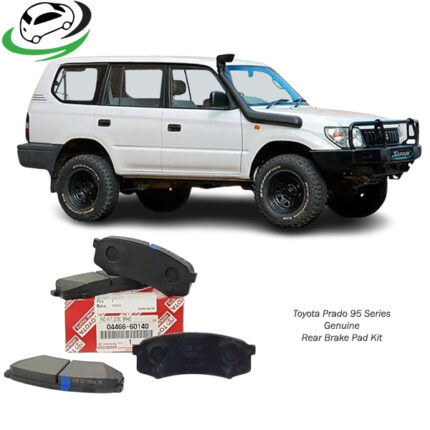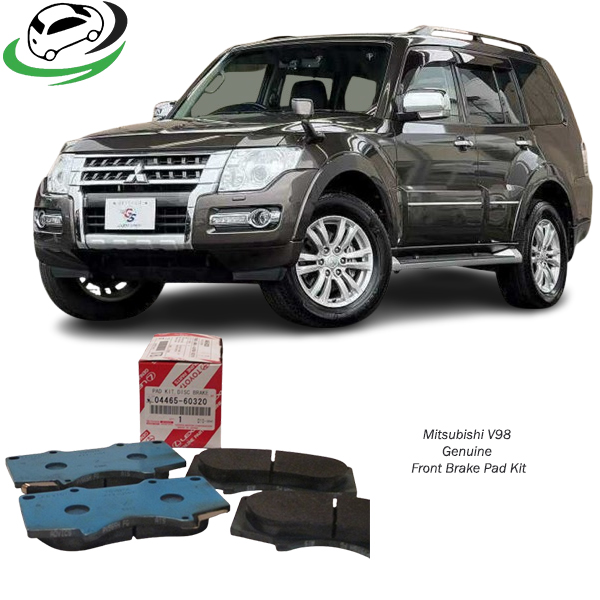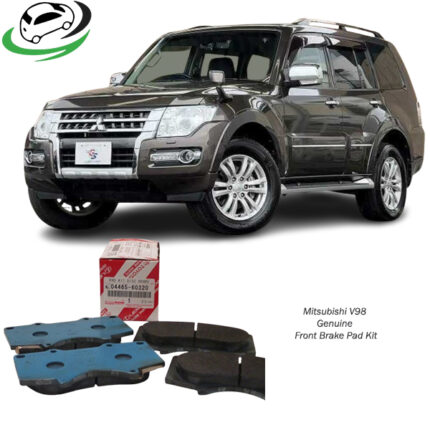Get Mitsubishi V98 Genuine Front Brake Pad Kit 0446560320
A genuine front brake pad kit is an essential part of a vehicle’s braking system, playing a critical role in ensuring your car’s safety, braking efficiency, and longevity. Front brake pads endure more stress than rear pads because most of the braking force is applied to the front wheels. In this comprehensive explanation, we will explore the function of front brake pads, the benefits of using genuine parts, different types of brake pad materials, key benefits, maintenance tips, and signs of wear.
Function of Front Brake Pads
The front brake pads are responsible for creating the necessary friction to stop or decelerate a vehicle. When you press the brake pedal, the brake calipers squeeze the pads against the brake rotors, generating friction that slows the wheel’s rotation. This process converts kinetic energy into heat, which is dissipated through the brake system.
Since most vehicles use a front-biased braking system, the front brake pads bear the majority of the load when braking. This is especially true when you make sudden stops, as the vehicle’s weight shifts forward, increasing the pressure on the front brakes. This makes the front brake pads critical for effective braking performance and vehicle safety.
Why Use Genuine Brake Pads?
Using genuine front brake pads ensures the highest level of quality, compatibility, and performance for your vehicle. These brake pads are made by the vehicle’s manufacturer or an approved Original Equipment Manufacturer (OEM), ensuring they meet the car’s specific design and performance standards.
- Guaranteed Compatibility: Genuine brake pads are designed to precisely match your vehicle’s specifications. This ensures a proper fit, optimal performance, and smooth braking action. Non-genuine or aftermarket parts may not provide the same level of compatibility, which can negatively impact braking efficiency.
- Enhanced Safety: Genuine brake pads go through rigorous testing to meet the highest safety standards. They are manufactured to withstand specific loads, temperatures, and driving conditions, ensuring your vehicle can stop safely even in emergency situations.
- Durability and Longevity: Authentic brake pads are built to last, reducing the frequency of replacements. Using genuine parts helps prevent uneven wear on the brake rotors and other components, extending the overall life of the braking system.
- Manufacturer’s Warranty: Genuine parts are typically covered by the vehicle manufacturer’s warranty, protecting you from defects or premature failures. Using non-genuine parts may void your warranty and result in additional costs if something goes wrong.
Types of Brake Pad Materials
Brake pads come in different materials, each offering distinct advantages in terms of performance, longevity, and braking characteristics. The most common types of materials used in front brake pads are:
- Ceramic Brake Pads: Ceramic brake pads are known for their quiet operation, low dust production, and long life. They are made from ceramic fibers, non-ferrous materials, and bonding agents. These pads perform well under a wide range of temperatures and driving conditions, making them ideal for everyday use. However, they may not provide the same level of stopping power as other materials in high-performance or heavy-duty situations.
- Semi-Metallic Brake Pads: Semi-metallic pads contain metal fibers such as steel, copper, or iron, combined with other materials. They offer excellent braking performance and heat dissipation, making them suitable for heavier vehicles or more aggressive driving. Semi-metallic pads tend to be noisier and generate more brake dust than ceramic pads, but they perform better under extreme conditions.
- Organic Brake Pads: Organic pads, sometimes called non-asbestos organic (NAO) pads, are made from materials like rubber, carbon, or fiberglass. They are softer than other types of brake pads, offering quieter operation and a smoother feel. However, organic pads wear out faster and are more suited for lighter vehicles that don’t require as much braking force.
- Low-Metallic NAO Brake Pads: Low-metallic NAO brake pads are similar to organic pads but include a small percentage of metal to improve braking performance and heat dissipation. These pads strike a balance between noise control, durability, and performance, making them a good option for everyday driving.
Benefits of Genuine Front Brake Pads
- Optimal Performance: Genuine brake pads are engineered to match the specifications of your vehicle, providing consistent and reliable braking performance. They offer the best balance between braking power, comfort, and wear resistance, ensuring that your vehicle stops smoothly and efficiently.
- Reduced Brake Fade: Genuine brake pads are made from high-quality materials that can withstand the high temperatures generated during braking. This minimizes brake fade, which occurs when the pads and rotors overheat, leading to reduced braking power.
- Noise Reduction: Many genuine brake pads come equipped with noise-dampening shims or other technologies to reduce squealing or grinding noises during braking. This ensures a quieter, more comfortable driving experience.
- Dust Control: Genuine front brake pads produce less brake dust than many aftermarket alternatives. This not only keeps your wheels cleaner but also reduces the wear and tear on other components, such as the brake rotors and calipers.
- Protection of Other Components: Using genuine brake pads helps to prevent premature wear on the brake rotors and calipers. Poorly made or incompatible brake pads can cause excessive wear on these parts, leading to costly repairs or replacements.
- Longer Life Span: Authentic front brake pads last longer than many aftermarket alternatives due to their high-quality materials and precise engineering. This means fewer replacements and lower long-term maintenance costs.
Maintenance Tips for Front Brake Pads
Regular maintenance of your front brake pads is key to ensuring the performance and safety of your braking system. Here are some maintenance tips to keep your front brake pads in top condition:
- Inspect Regularly: Check your front brake pads every 10,000 to 15,000 miles. Visual inspections can reveal uneven wear or damage to the pads. If the pads are less than 3-4 mm thick, it’s time to replace them.
- Brake Fluid Check: The brake system relies on hydraulic pressure to function properly, so regularly check your brake fluid levels. Low or dirty brake fluid can compromise the performance of your brake pads.
- Clean Brake Components: Brake dust can accumulate on the pads and rotors, reducing the effectiveness of the braking system. Regularly cleaning your brake components will help maintain optimal performance.
- Avoid Hard Braking: Avoid aggressive braking whenever possible. Hard braking generates excessive heat, which can cause the pads to wear out faster. Try to brake smoothly and gradually to prolong the life of your brake pads.
- Rotate Tires: Regularly rotating your tires helps to distribute the braking forces more evenly across all four wheels. This can prevent premature wear on the front brake pads, extending their life.
- Listen for Noises: Pay attention to any unusual noises when braking. Squealing, grinding, or vibrations in the brake pedal could indicate that your front brake pads need to be replaced or that there’s an issue with another component of the braking system.
Signs of Worn-Out Front Brake Pads
It’s crucial to know the signs of worn-out front brake pads to avoid compromising the safety and performance of your vehicle. Here are the most common warning signs:
- Squealing or Screeching Noise: A high-pitched squealing sound when you brake is a clear sign that the brake pads are worn down and need replacement. Many brake pads have built-in wear indicators that produce this noise as a warning.
- Grinding Sound: If you hear a grinding noise, it means the brake pads are completely worn out, and the metal backing is rubbing against the rotor. This can cause significant damage to the rotors and calipers, leading to costly repairs.
- Reduced Braking Power: If it takes longer to stop or the brake pedal feels soft or spongy, this could be a sign that your front brake pads are worn out or the brake fluid is low.
- Vibration When Braking: If you feel a vibration or pulsing in the brake pedal when you apply the brakes, it could be due to uneven wear on the brake pads or warped rotors.
- Brake Warning Light: Some vehicles are equipped with a brake pad wear sensor that triggers a warning light when the pads need to be replaced. If this light comes on, have your brake system inspected immediately.
Conclusion
A genuine front brake pad kit is essential for maintaining your vehicle’s braking performance and safety. By choosing genuine brake pads, you ensure that your vehicle’s braking system functions as intended, providing reliable stopping power, longer-lasting components, and enhanced safety. Regular inspections and maintenance, along with using genuine parts, will help you avoid costly repairs and ensure your vehicle stops safely and efficiently in any situation.
Follow us on Facebook for more parts.





Reviews
Clear filtersThere are no reviews yet.